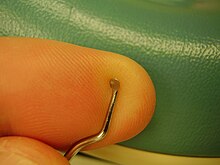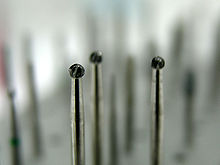Excavator
An excavator (from Latin : cavo = I hollow out) is a double-sided dental hand instrument for removing carious dentin near the pulp (tooth pulp ) before placing a filling .
"Excavator" is the English word for excavator .
At both working ends, the instrument has small, sharp spoons about 1–2 millimeters in diameter, similar to a sharp spoon . With these, the carious tissue is scratched out (excavated). Although this can already be recognized by its brown color, it can also be colored by a special drug ( caries detector ).
The excavator is one of the oldest devices for removing tooth decay. More modern alternatives are turbine-powered diamond cutter and round drill of hard metal , and for some years and the laser .
If the instrument is used with little pressure, the treatment is relatively painless even without anesthesia (numbing) . Furthermore, the turbine noise and other drilling noises are eliminated . On the one hand, this reduces vibrations and fear of noise; on the other hand, better communication between dentist and patient is possible during treatment. However, the significantly longer treatment time is a disadvantage. In addition, if you work inaccurately, there is a greater risk that already infected dentin will not be completely removed.
The excavator is still required to prepare an adhesive gold filling ( gold hammer filling ). For the preparation of conventional fillings, the instrument had gone out of fashion for a few decades, but has recently experienced a renaissance in children's dentistry , as anxious children especially find the vibration of the rose burrs unbearable. This instrument can also be used for treatment without electricity , which is especially important when working in underdeveloped regions of the world.


